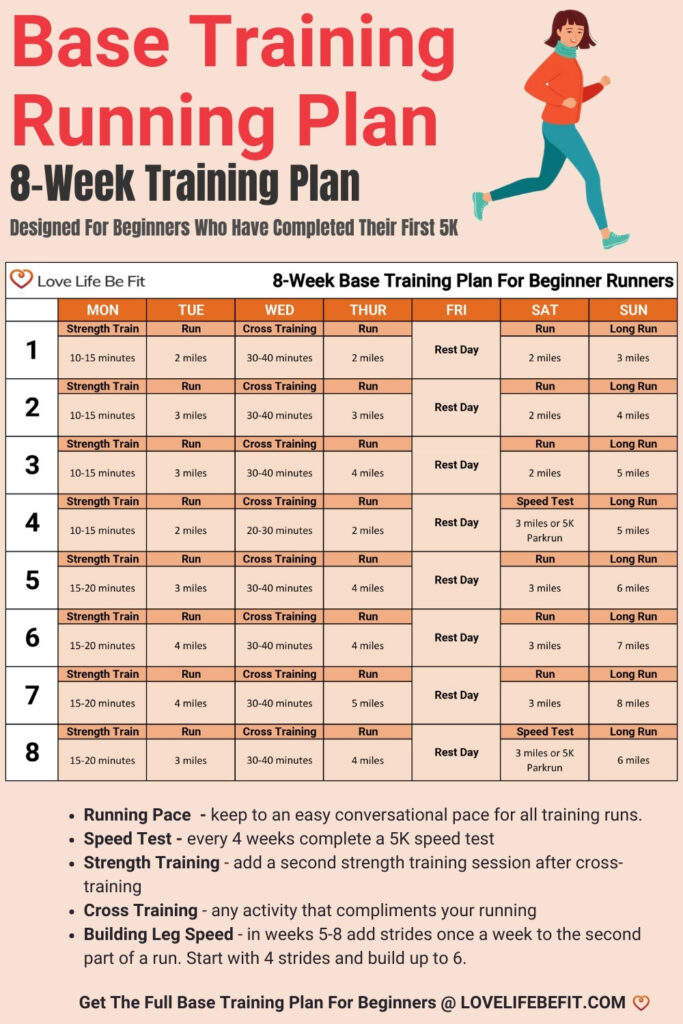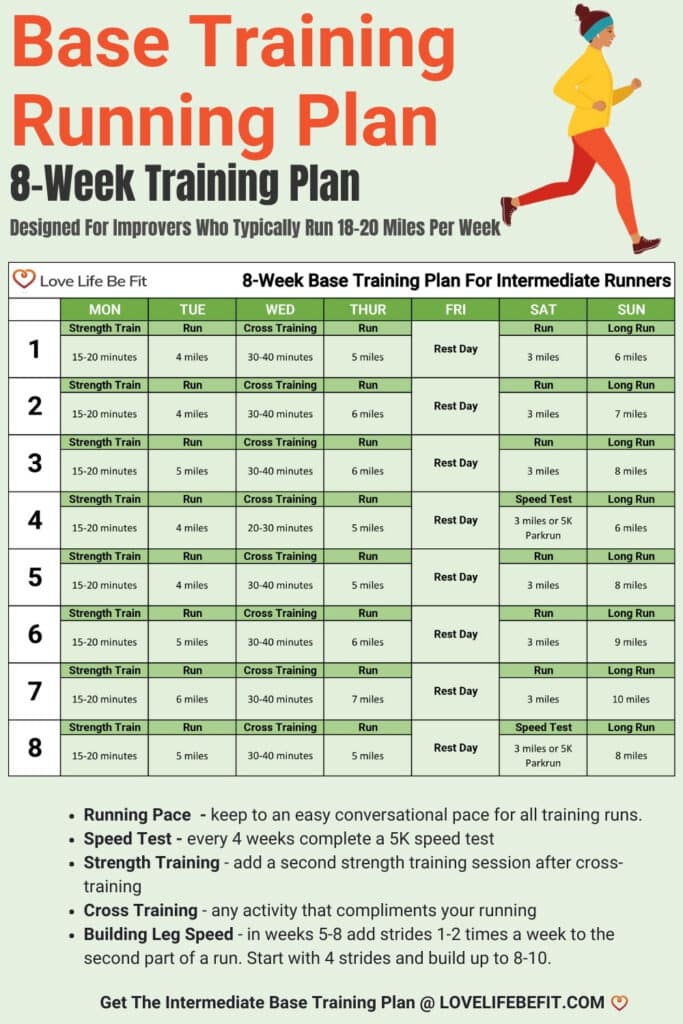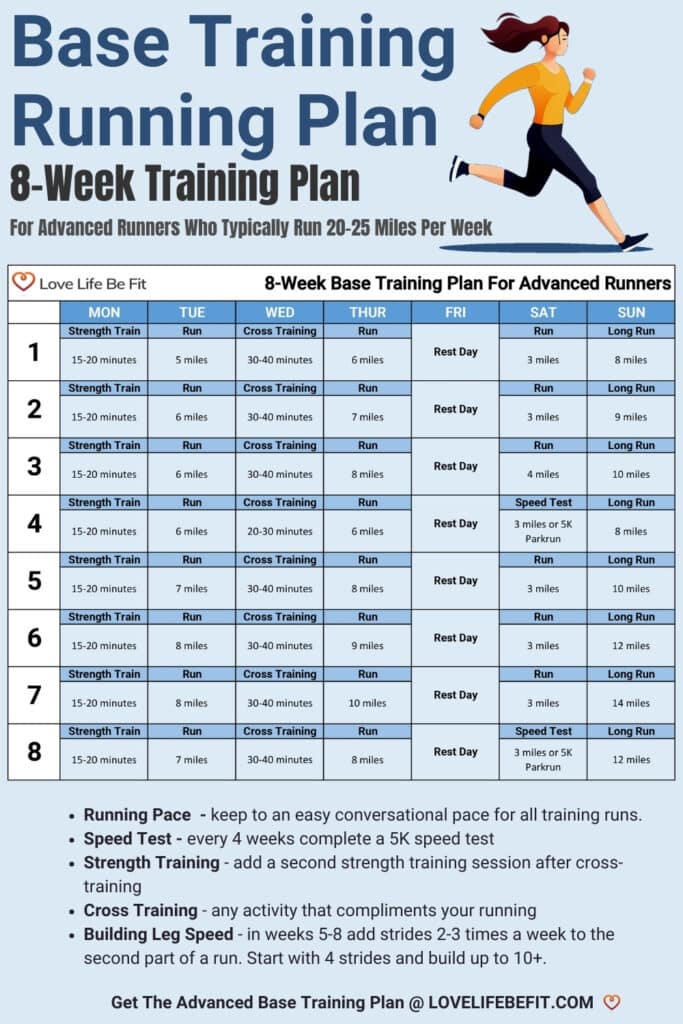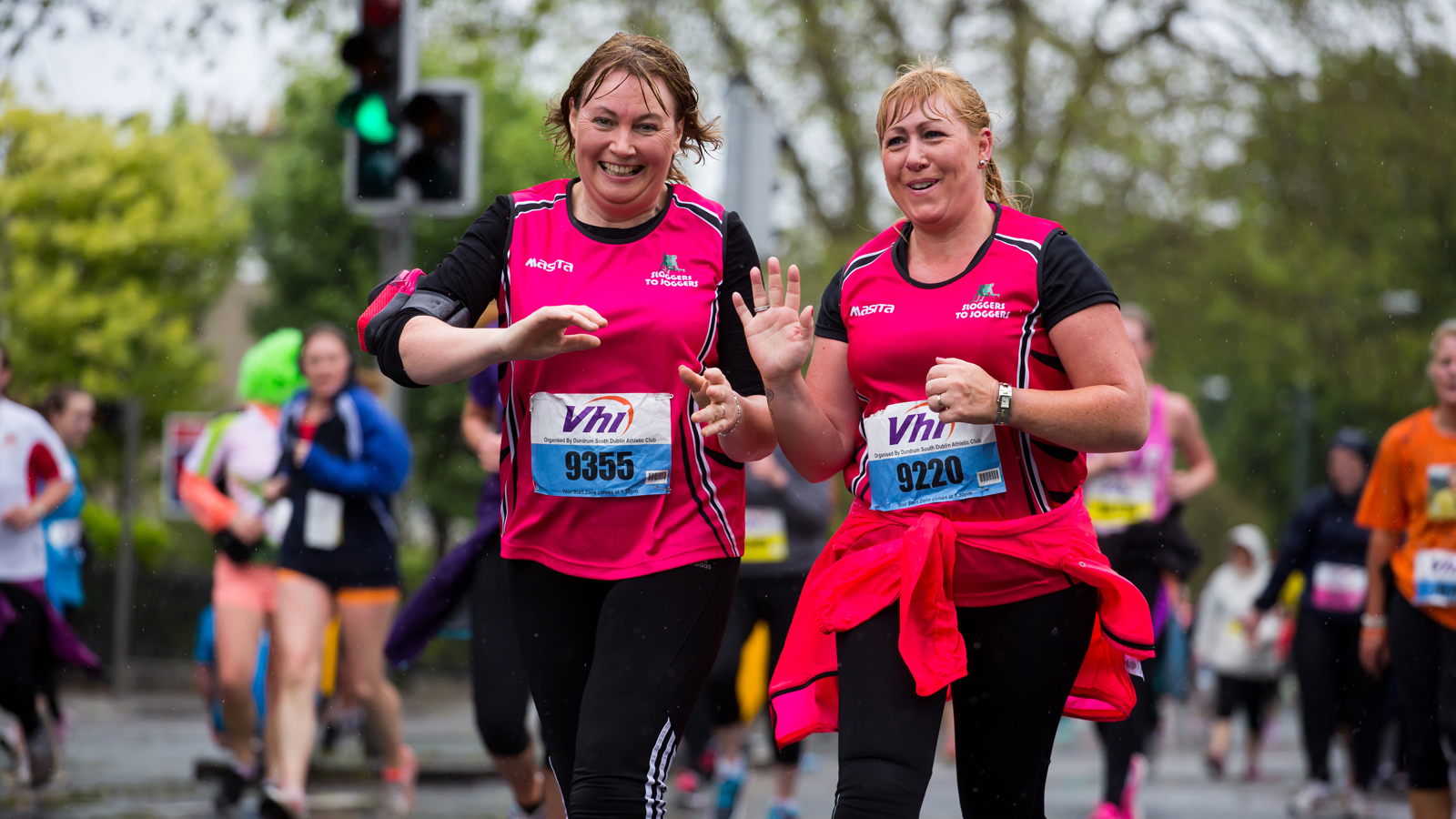Base Running Training Plan: Printable 8-Week Plan
What is base training for running? What are the benefits and when should you be doing it? This post dives into the reasons for base building and provides base training plans for beginners and experienced runners.

When Should You Be Base Training For Running?
There are 3 good reasons to start base training:
- Building resilience and strength when you’re a beginner runner.
- Easing back into running after an injury or layoff
- Improving your aerobic capacity before starting a race-specific training plan.
The concept of base training originated with the former New Zealand running coach Arthur Lydiard. His athletes started dominating athletics in the 1960s winning Olympic medals at all distances from 800m to the marathon.
Key to their success was a period of base training for runners – long slow easy running but with a high weekly mileage.
Typically lasting 8 to 12 weeks, the base training phase leads into race-specific training such as marathon training. It’s not just for advanced runners, training with long easy runs helps beginners avoid the impact stresses of more intense workouts and improvers become stronger, better runners.
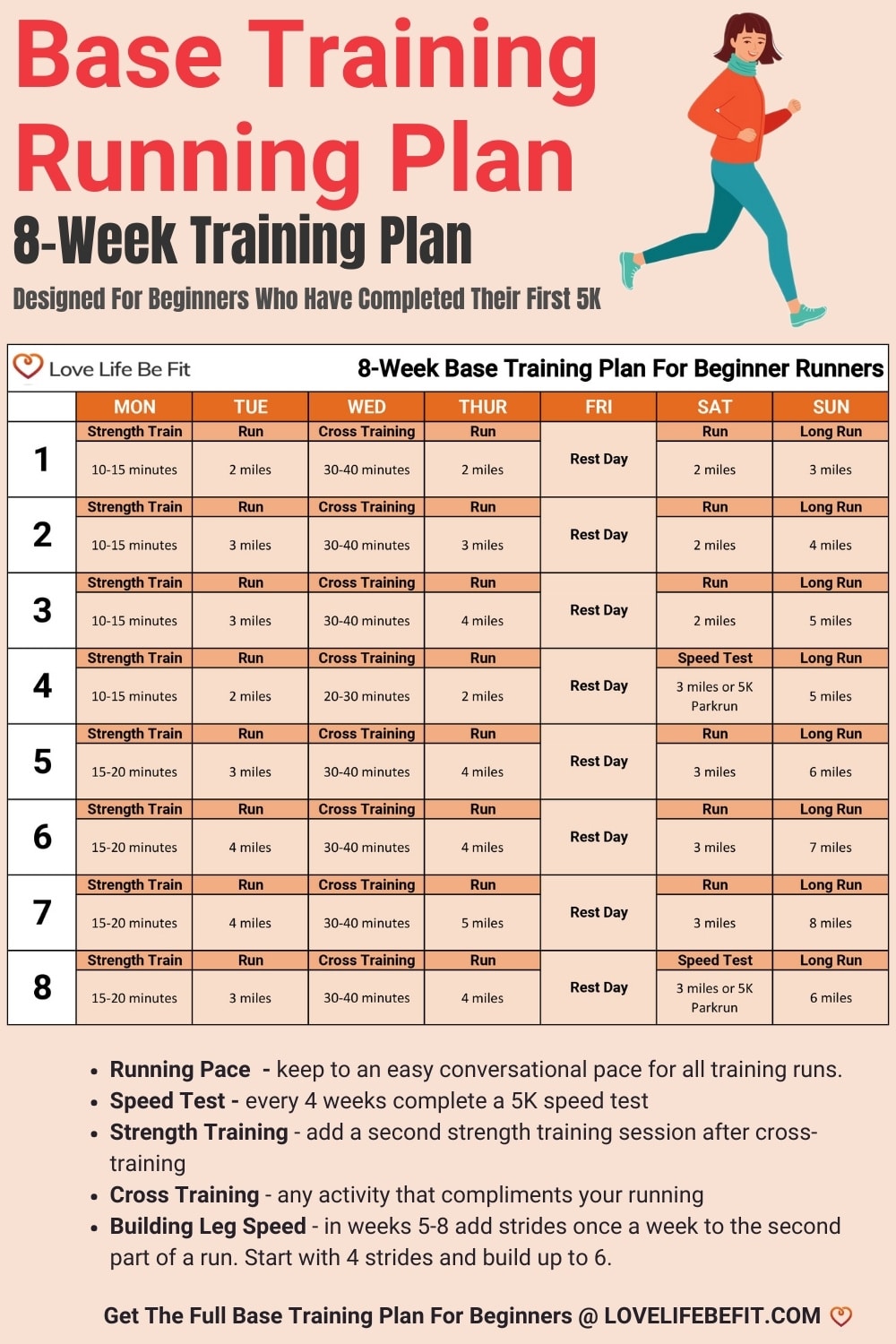
Benefits Of Base Training
The aims and benefits of base training are:
Improve aerobic capacity and endurance.
Base training improves both your aerobic capacity – the ability to take in and utilize oxygen and your aerobic endurance – your efficiency at utilizing oxygen.
When you first start running or return after a layoff, your body increases the number of red blood cells and becomes better at pumping oxygenated blood around your body.
Keep training and your body increases the number of capillaries around your muscle cells delivering more blood to your working muscles. Within these muscle cells, your body builds more mitochondria. More mitochondria means more energy and your body makes them bigger and better.
The result is improved an improved aerobic base. You’ll be able to sustain a fast pace for a longer period and this ability comes from base training.
Strengthen muscles, bones, and joints
Running is a high-impact sport and many runners risk injury by running too hard too soon when they first begin running.
With base building the intensity of running is low and the body is able to grow stronger and recover despite the frequent runs. Those easy miles allow your muscles, tendons, fascia, bones, and joints to strengthen.
Beginner runners should always spend time on base training before introducing speed work and harder sessions to their training.
It’s also a good time to work on strength training, combining those easy runs with core work and bodyweight exercises.
Improve your fat-burning capability
Distance running depends on two energy systems – muscle-glycogen stores and fat-burning. Your glycogen (carbohydrate) stores are limited and on longer runs your body is forced to rely on burning your stores of fat.
With base training your body adapts to fat-burning so you don’t get that debilitating feeling of running on empty. Also, by draining your muscle’s glycogen, your body reacts by increasing its stores – that’s a huge advantage for fast-paced racing.
Improves endurance of your fast-twitch muscle fibers
Long slow base building runs rely on slow-twitch muscle fibers. But when these fibers fatigue towards the end of long runs, the body calls on its fast-twitch muscle fibers to help out.
The result: fast-twitch muscle fibers with the endurance characteristics of slow-twitch fibers and a body that can run faster for longer!
Train your mind to resist fatigue
Lydiard talked about a “tireless state” – a mind so used to running it’s resistant to fatigue. Base training will help you keep running when you’re tired.
Your mind will stop sending you signals urging you to stop and you’ll be building your mental toughness.
Base Building Running Plan For Beginners
You can follow a structured training plan or gradually increase your mileage based on your current training level.
The most important point about base training is to increase your weekly mileage gradually, a few miles a week. For some people base training is 20 miles a week, for others, it’s 40+ but you don’t go from 20 to 40 miles per week overnight.

Who Is This Plan For?
This training plan is aimed at beginner runners who’ve just completed their first 5K and want to build a strong foundation. If you’ve been following our Couch To 5K Plans, you’ll typically be running for 30 minutes, 3 times a week and cross-training 2 days a week. A total of around 8 to 10 miles per week.
Base Building Running Plan For Intermediate Runners
Improving runners will benefit just as much as beginners from base training. It may not be the most exciting training but adding base building to your training process will set you up to achieve your running goals.
Going back to basics and base building once or twice a year is ideal. Think of it as part of your training cycle – a way to recover and rebuild after a racing season or a big race.
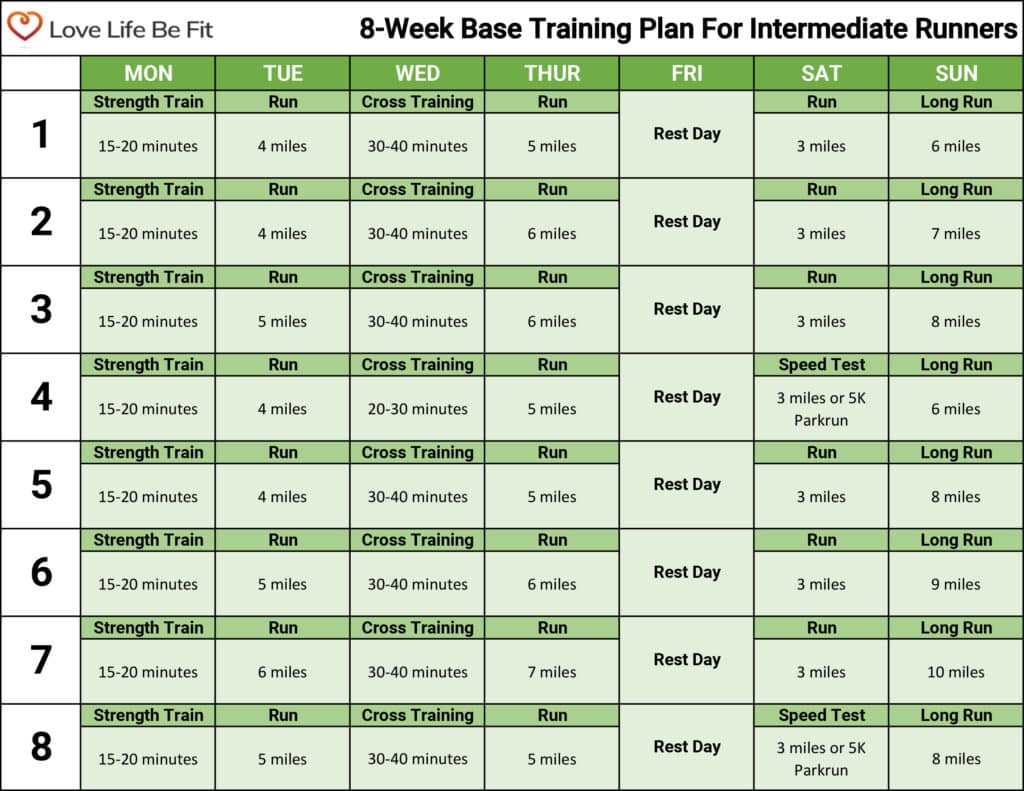
Who Is This Plan For?
If you’ve followed our Couch to 10K or 5K To 10K Training Plan, this Intermediate Base Training Plan is an ideal option for continuing your running after your 10K race.
The plan assumes you have a mileage base of 18 to 20 miles a week over 4 sessions with one session of cross-training. If you’ve just completed the Base Building Running Plan For Beginners, this plan is a natural extension.
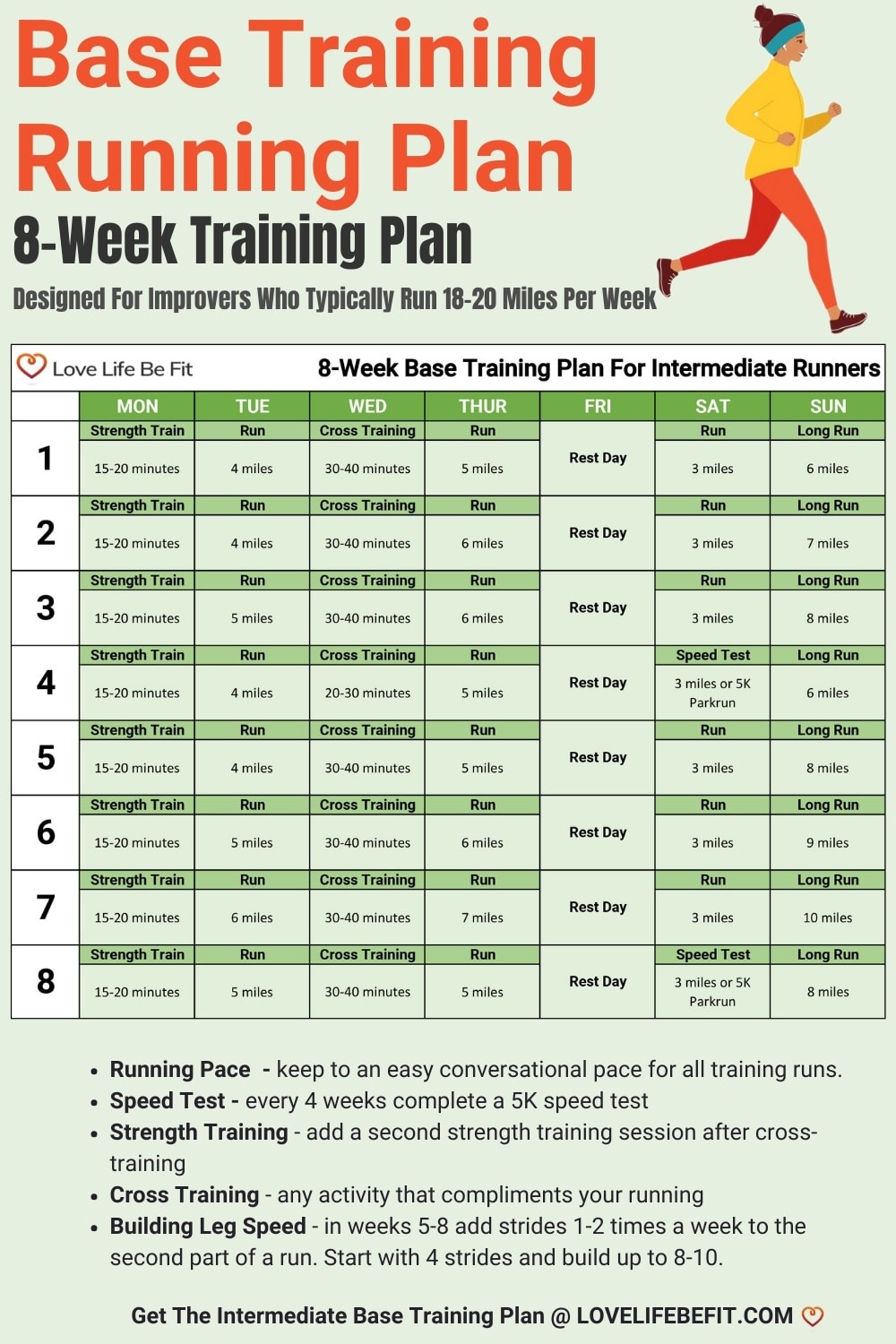
Base Building Running Plan For Advanced Runners
Most experienced runners will be able to build a base building plan that matches their current mileage level but this plan is here to help.
Good runners are just as capable of getting carried away as beginners. You may have designs on running 70 to 100 miles a week but it can take several years of experience to build up this higher mileage. Try and keep a check on your enthusiasm to stay injury-free.
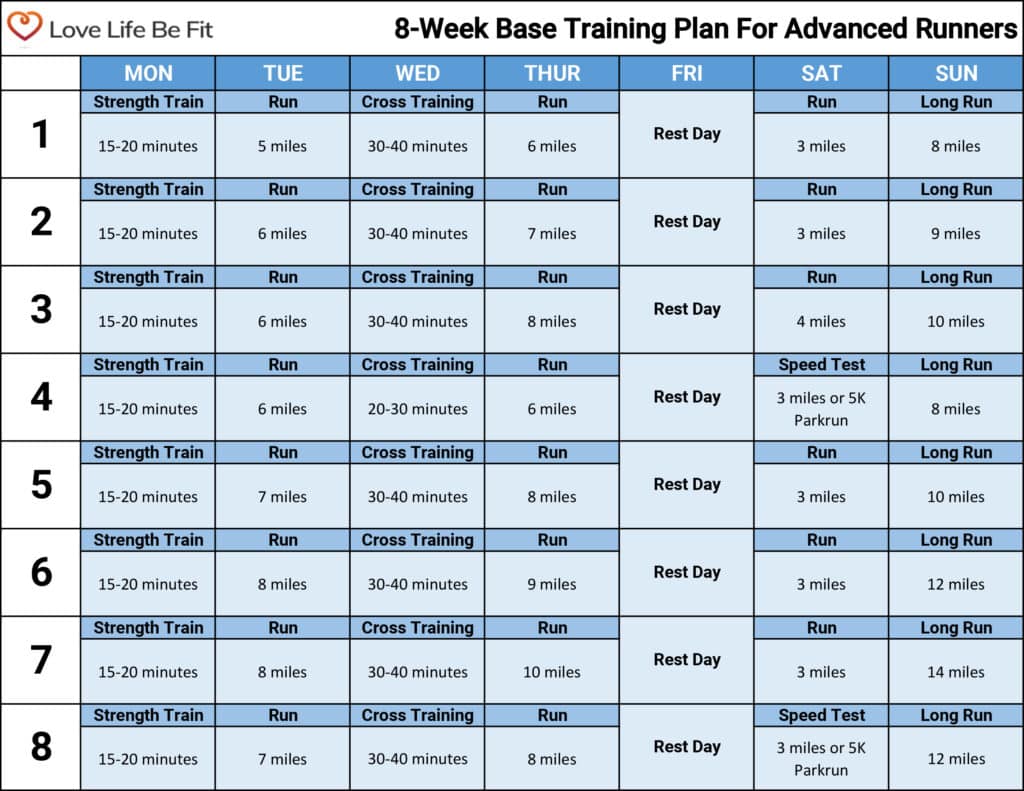
Who Is This Plan For?
This plan is for runners who are consistently running 20 to 25 miles per week. It can be a good option for continuing training after our Couch To Half Marathon Plan or could follow on from our Intermediate Base Building Plan if you want to extend your base training to 12 or 16 weeks.
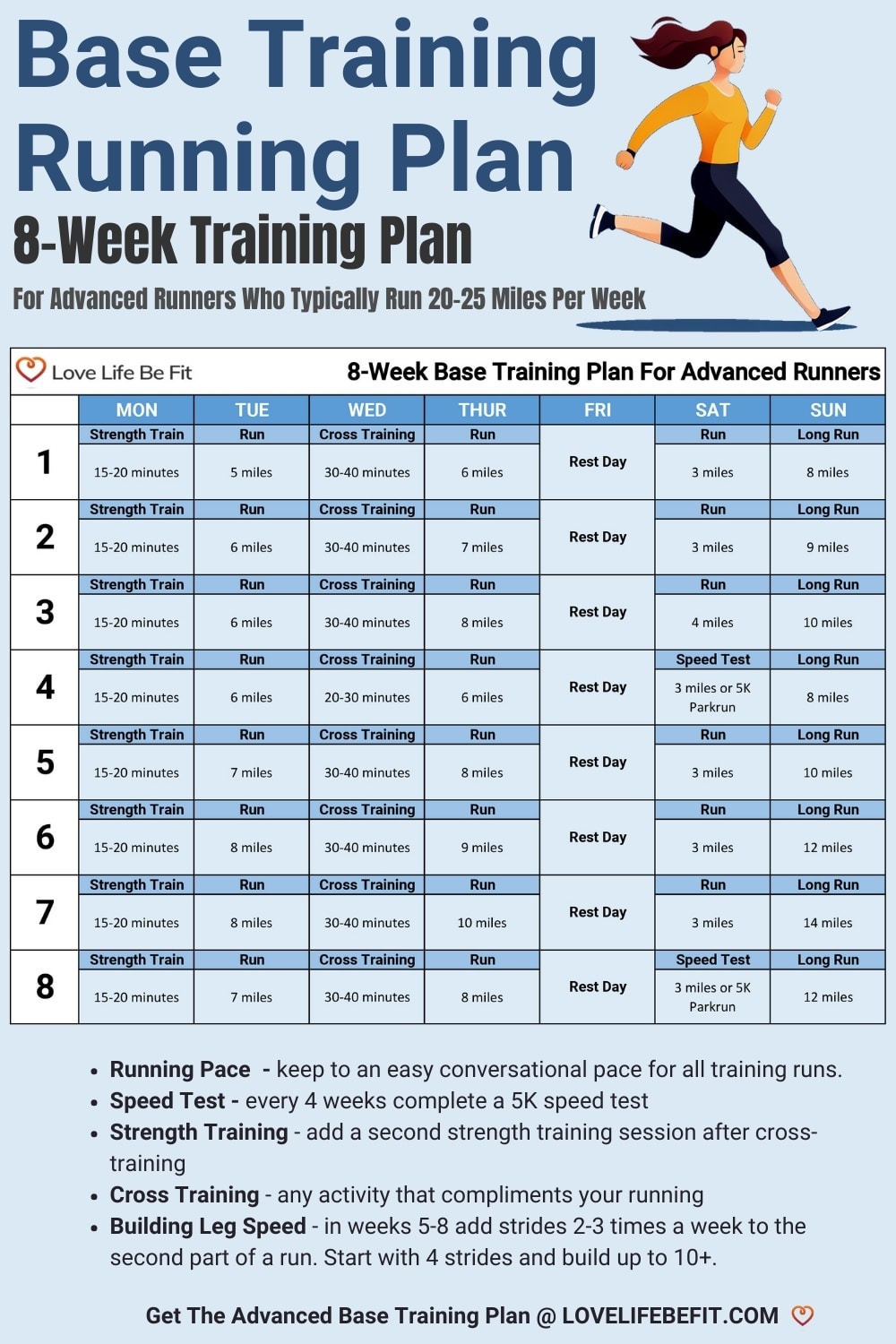
Base Running Training Plan Notes
These notes apply to all plans:
Running Pace
Keep to an easy conversational pace for all training runs. This is an RPE of 3 on our chart where RPE stands for Rating of Perceived Exertion.
Ignore your watch and run to feel. If you’re running up steep hills walk if you need to.
Speed Test
Every 4 weeks the schedules include a speed test. It can be any distance but we suggest a 5K parkrun.
Let rip and see what happens. You may be surprised by how fast you run after 4 weeks of easy-paced running. Warm up before the 5K and cool down afterward.
Strength Training
The plans include one session of strength training per week but it’s advisable to add a second short session on your cross-training day.
Cross Train
This can be any activity that complements your running. Find out more about cross-training for runners.
Building Leg Speed
It’s a good idea to introduce leg speed training to the latter part of your plan. If you’re completing a standard 8-week plan, introduce the speedwork in the last 4 weeks.
If you’re combining two 8-week plans back to back, for example, the beginner and intermediate plan, add leg speedwork to the last 8 weeks.
Add running strides in the middle or at the end of your run 1-3 times per week. Run fast for 10 to 25 seconds then jog for up to 2 minutes depending on feel. You should be fully recovered before the next stride.
Start with just 4 strides and increase the number you run gradually. Beginners will run around 4 to 6 strides, intermediate runners can build up to 8 to 10 and experienced runners will aim for 10+.
Strides should feel effortless. Ease into your fast pace over the first 5 seconds. After 5 seconds, at your full speed, focus on staying relaxed – relaxed facial muscles, good arm action, and think about landing on your midfoot, not your heel.
Maintain until it feels natural to slow to a stop over the last 5 seconds. In total, your stride interval length should be about 20 to 30 seconds.
Find out more in our post about how to run a mile faster. It can be a good idea to run your strides on softer ground in a park or similar instead of on the road.

Thoughts From Love Life Be Fit
Base training may not be the most exciting type of running but it’s an important process to help beginner runners build a resilient runner’s body. It also helps experienced runners take a break from the pressure of racing to prepare for their next season.
All runners should try and add one or two blocks of base building to their schedule every year – the results can be impressive!
Running 101 Training Guides & Walking Schedules
5K Training Plans
- Couch To 5K Beginner Training Plan
- 12 Week 5K Training Plan
- 10 Week 5K Training Plan
- 8 Week 5K Training Plan
- 6 Week 5K Training Plan
- 4 Week 5K Training Plan
- 5K Training Plan Intermediate
